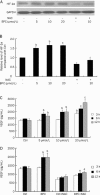N-benzyl-5-phenyl-1H-pyrazole-3-carboxamide promotes vascular endothelial cell angiogenesis and migration in the absence of serum and FGF-2
- PMID: 21293473
- PMCID: PMC4009934
- DOI: 10.1038/aps.2010.201
N-benzyl-5-phenyl-1H-pyrazole-3-carboxamide promotes vascular endothelial cell angiogenesis and migration in the absence of serum and FGF-2
Abstract
Aim: To investigate the effect of N-benzyl-5-phenyl-1H-pyrazole-3-carboxamide (BPC) on angiogenesis in human umbilical vein endothelial cells (HUVECs).
Methods: Capillary-like tube formation on matrigel and cell migration analyses were performed in the absence of serum and fibroblast growth factor (FGF-2). Reactive oxygen species (ROS) were measured using a fluorescent probe, 2', 7'- dichlorodihydrofluorescein (DCHF). The nitric oxide (NO) production of HUVECs was examined using a NO detection kit. Morphological observation under a phase contrast microscope, a viability assay using 3-[4, 5-dimethylthiazol-2-yl]-2, 5-diphenyl-tetrazolium (MTT) and a lactate dehydrogenase (LDH) activity analysis by a detection kit were performed to evaluate the toxicity of BPC on HUVECs in the presence of serum and FGF-2. The level of hypoxia-inducible factor 1α (HIF-1α) and the release of vascular endothelial growth factor (VEGF) were measured by Western blot and ELISA, respectively.
Results: In the absence of serum and FGF-2, cells treated with BPC (5-20 μmol/L) rapidly aligned with one another and formed tube-like structures within 12 h. In the presence of serum and FGF-2, cells treated with BPC for 24, 48 and 72 h had no changes in morphology, viability or LDH release compared with the control group. Cell migration in the BPC-treated group was significantly increased compared with the control group. During this process, NO production and ROS level were elevated dramatically, and the levels of HIF-1α and VEGF were increased dependent on the generation of ROS.
Conclusion: BPC most effectively promoted angiogenesis and migration in HUVECs in the absence of FGF-2 and serum.
Figures






Similar articles
-
Melatonin restricts the viability and angiogenesis of vascular endothelial cells by suppressing HIF-1α/ROS/VEGF.Int J Mol Med. 2019 Feb;43(2):945-955. doi: 10.3892/ijmm.2018.4021. Epub 2018 Dec 10. Int J Mol Med. 2019. PMID: 30569127 Free PMC article.
-
Discovery of a pyrazole derivative promoting angiogenesis through modulating reactive oxygen species and interferon-inducible protein 10 levels.Mol Biol Rep. 2011 Mar;38(3):1491-7. doi: 10.1007/s11033-010-0256-2. Epub 2010 Sep 15. Mol Biol Rep. 2011. PMID: 20842451
-
Adrenomedullin promotes angiogenesis in epithelial ovarian cancer through upregulating hypoxia-inducible factor-1α and vascular endothelial growth factor.Sci Rep. 2017 Jan 16;7:40524. doi: 10.1038/srep40524. Sci Rep. 2017. PMID: 28091613 Free PMC article.
-
Platelet-activating factor (PAF) induces corneal neovascularization and upregulates VEGF expression in endothelial cells.Invest Ophthalmol Vis Sci. 2004 Sep;45(9):2915-21. doi: 10.1167/iovs.04-0128. Invest Ophthalmol Vis Sci. 2004. PMID: 15326102
-
Human umbilical vein endothelial cells and human dermal microvascular endothelial cells offer new insights into the relationship between lipid metabolism and angiogenesis.Stem Cell Rev. 2006;2(2):93-102. doi: 10.1007/s12015-006-0015-x. Stem Cell Rev. 2006. PMID: 17237547 Review.
Cited by
-
FGF18 alleviates sepsis-induced acute lung injury by inhibiting the NF-κB pathway.Respir Res. 2024 Feb 28;25(1):108. doi: 10.1186/s12931-024-02733-1. Respir Res. 2024. PMID: 38419044 Free PMC article.
-
Pyrazole Derivatives Induce Apoptosis via ROS Generation in the Triple Negative Breast Cancer Cells, MDA-MB-468.Asian Pac J Cancer Prev. 2021 Jul 1;22(7):2079-2087. doi: 10.31557/APJCP.2021.22.7.2079. Asian Pac J Cancer Prev. 2021. PMID: 34319030 Free PMC article.
-
Troubleshooting the dichlorofluorescein assay to avoid artifacts in measurement of toxicant-stimulated cellular production of reactive oxidant species.J Pharmacol Toxicol Methods. 2013 Mar-Apr;67(2):56-60. doi: 10.1016/j.vascn.2013.01.195. Epub 2013 Feb 4. J Pharmacol Toxicol Methods. 2013. PMID: 23380227 Free PMC article.
-
Pseudolaric acid B-driven phosphorylation of c-Jun impairs its role in stabilizing HIF-1alpha: a novel function-converter model.J Mol Med (Berl). 2012 Aug;90(8):971-81. doi: 10.1007/s00109-012-0865-4. Epub 2012 Mar 10. J Mol Med (Berl). 2012. PMID: 22406864
References
-
- Chunga BH, Leec JJ, Kimb JD, Jeoungd D, Leed H, Choe J, et al. Angiogenic activity of sesamin through the activation of multiple signal pathways. Biochem Biophys Res Commun. 2009;391:254–60. - PubMed
-
- Xia Y, Fan CD, Zhao BX, Zhao J, Shin DS, Miao JY. Synthesis and structure-activity relationships of novel 1-arylmethyl-3-aryl-1H-pyrazole-5-carbohydrazide hydrazone derivatives as potential agents against A549 lung cancer cells. Eur J Med Chem. 2008;43:2347–53. - PubMed
-
- Fan CD, Zhao BX, Wei F, Zhang GH, Dong WL, Miao JY. Synthesis and discovery of autophagy inducers for A549 and H460 lung cancer cells, novel 1-(2′-hydroxy-3′-aroxypropyl)-3-aryl-1H-pyrazole-5-carbohydrazide derivatives. Bioorg Med Chem Lett. 2008;18:3860–4. - PubMed
-
- Zhao BX, Zhang L, Zhu XS, Wan MS, Zhao J, Zhang Y, et al. Synthesis and discovery of a novel pyrazole derivative as an inhibitor of apoptosis through modulating integrin beta4, ROS, and p53 levels in vascular endothelial cells. Bioorg Med Chem. 2008;16:5171–80. - PubMed
Publication types
MeSH terms
Substances
LinkOut - more resources
Full Text Sources

